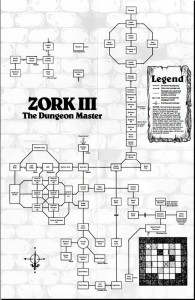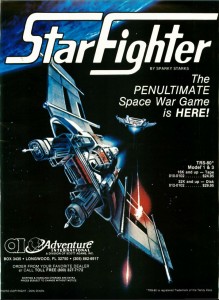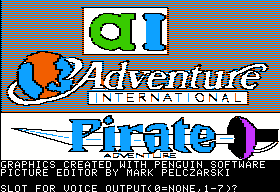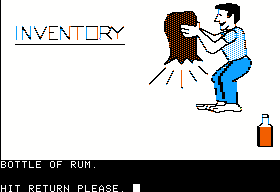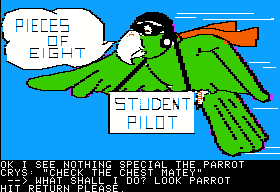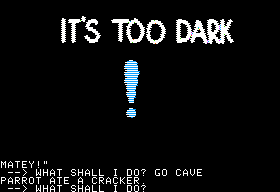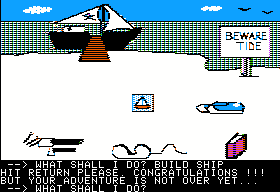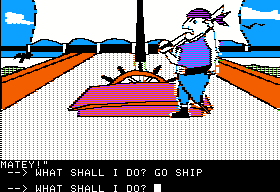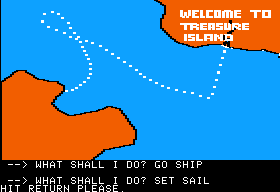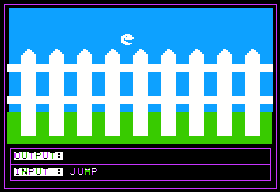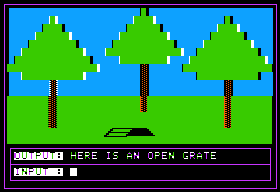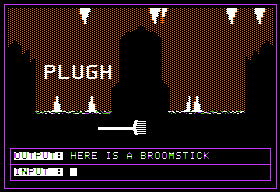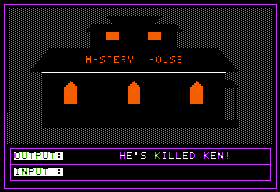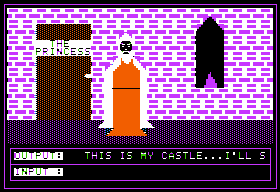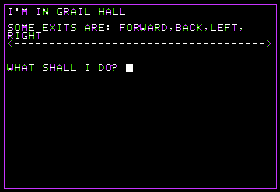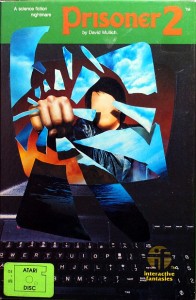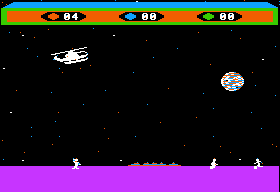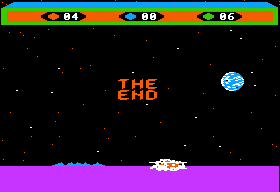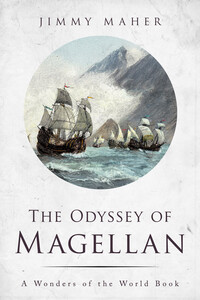In September of 1982 Infocom released their fourth and fifth games, and their second and third of that year, simultaneously. Starcross, by Dave Lebling, was an outer-space adventure in the mold of Arthur C. Clarke’s Rendezvous with Rama. We’ll get to that shortly. But today I want to talk about Zork III: The Dungeon Master, the next installment in Infocom’s flagship series.
Although its endgame and one rather elaborate puzzle are borrowed from the PDP-10 Zork, the rest of Zork III is an original work of the indefatigable Marc Blank, a fellow whom I’m coming more and more to recognize as perhaps the key influence behind the Infocom Way. This is after all the guy who co-authored the original PDP-10 Zork, who worked tirelessly to make the parser better, who designed the Z-Machine, who expanded the very definition of an adventure game via Deadline. Zork III isn’t so obviously groundbreaking as Deadline, but it’s a better, more mature piece of work — better than anything that had come before, not only from Infocom, but from anyone. That’s not to say that it’s an easy game. No, it’s hard as nails. Yet it’s difficult for all the right reasons. Here you’ll find no mazes or useless geography, no riddles, no parser games, no hunger or light-source timers or inventory limits (that matter, anyway). No bullshit. You’ll just find a small assortment of puzzles that are more intricate and satisfying than anything we’ve seen before, couched in the most evocative of atmospheres.
As I’ve mentioned before, Zork has always had a schizophrenic personality. The series has never quite decided whether it wants to be goofy, mildly satirical comedies full of the over-the-top excesses of the Flathead clan or mournful tragedies played out amidst the faded grandeur of the erstwhile Great Underground Empire. The PDP-10 game and the first PC game vacillated wildly between both extremes, while Zork II, largely the work of Dave Lebling, played up the light comedy. Zork III is not without some well-placed Flathead jokes, but its main atmosphere is one of windy austerity, with a distinct twinge of sadness for better times gone by. It begins thus:
As in a dream, you see yourself tumbling down a great, dark staircase. All about you are shadowy images of struggles against fierce opponents and diabolical traps. These give way to another round of images: of imposing stone figures, a cool, clear lake, and, now, of an old, yet oddly youthful man. He turns toward you slowly, his long, silver hair dancing about him in a fresh breeze. "You have reached the final test, my friend! You are proved clever and powerful, but this is not yet enough! Seek me when you feel yourself worthy!" The dream dissolves around you as his last words echo through the void....
“Your old friend, the brass lantern, lies at your feet,” we are soon told, a sentence that well-nigh drips with Zork III‘s new-found world-weariness. And indeed, we’re a long way from the famous white house. If Zork I, with its points-for-treasures plot, is almost the prototypical adventure game, Zork III, just as much as the Prisoner games, is all about subverting our expectations of what makes an adventure game. Its most remarkable, peculiar achievement is to simultaneously be a damn good play within the confines of the genre it happily subverts.
But, onward. Here’s a map of the geography, in case you’d like to follow along as I explore, or (better yet) play along. I’m going to make a real effort not to spoil Zork III as thoroughly as I traditionally have in these analyses; it’s eminently worth struggling with a bit for yourself. My nudges, plus the map and the list of objects to be discovered in each room thereon, will hopefully blunt some of the edges of difficulty while leaving the heart of the experience intact.
From the Endless Stair where we began, we move south into the Junction. Another old friend, our sword, is embedded in a stone here, but there’s no way to pull it out. This “puzzle” is not really a puzzle at all; the sword will come to us, unbidden, when the time comes.
So, we move westward. We climb down a cliff to discover just the thing for an adventurer like us: a treasure chest — albeit a locked one. As we’re fiddling with it:
At the edge of the cliff above you, a man appears. He looks down at you and speaks. "Hello, down there! You seem to have a problem. Maybe I can help you." He chuckles in an unsettling sort of way. "Perhaps if you tied that chest to the end of the rope I might be able to drag it up for you. Then, I'll be more than happy to help you up!" He laughs again.
Every instinct tells us not to trust this guy; Zork I and Zork II have taught us that pretty much everyone in the Great Underground Empire is against us. Surely this fellow just wants to make off with our loot. And what else is an adventure game about if not collecting loot? Sure enough, if we take a chance and do as he asks we learn our suspicions were correct.
The man starts to heave on the rope and within a few moments you arrive at the top of the cliff. The man removes the last few valuables from the chest and prepares to leave. "You've been a good sport! Here, take this, for whatever good it is! I can't see that I'll be needing one!" He hands you a plain wooden staff from the bottom of the chest and begins examining his valuables.
Yet — and here’s where the subversion comes in — the treasure doesn’t matter. The old staff is what we need.
By this point we’ve already noticed something else very strange about Zork III: its scoring system seems completely out of whack. There are just 7 points to be scored, not the hundreds which we’ve come to expect from the earlier games. Further, points are awarded for such innocuous actions as just wandering into a certain completely accessible room, while major breakthroughs go unremarked. It’s possible to have 6 or 7 points and still be completely at sea, nowhere close to actually, you know, solving the game. Once again it seems that Zork III is playing by new rules that we don’t quite understand.
Yet Zork III is a finely crafted adventure as well as a subversive one, the first from Infocom without any howlingly bad design choices. We see this demonstrated in a rather surprising way on the Flathead Ocean. If we stand around here for a randomly determined number of turns, a ship will show up. Then we have one turn to say “Hello, sailor” to receive a potion of invisibility. “Hello, sailor” was a running joke throughout the first two Zork games; thus its appearance here, where it’s finally good for something. For the real oldtimers, there’s also a bit of even more meta meta-humor here: there’s a trivia quiz in the endgame of the original PDP-10 Zork about Zork itself. One of the possible questions is, “In which room is ‘Hello, Sailor’ useful?” The correct answer, in that game, is “None.”
Meta-humor aside, this business on the Flathead Ocean is on the face of it a staggeringly awful puzzle. First we must magically divine that we need to wait around in an otherwise uninteresting location (shades of Catherine the Great’s hairpin from Time Zone); then we must type the One True Thing from a multitude of choices. None of which, of course, would have stopped On-Line or perhaps even an earlier incarnation of Infocom from shoving it in there and being done with it. It’s exactly the sort of puzzle early adventure implementers loved, being trivial to code yet vastly extending the playing time of the game with its sheer obtuseness. Here, however, it’s not actually necessary. The potion only provides an alternate solution to a puzzle in the endgame. Thus the puzzle stands as an Easter egg only for the hardcore who like to plumb every depth and ferret out every secret. I don’t know of a better example of Infocom’s fast-evolving design sensibility than the decision not to make solving this bad puzzle necessary to winning the game.
But there are other, positive rather than negative examples of said sensibility. West of the lake we find what may just be my favorite puzzle in the game, a puzzle which is everything the arbitrary seaside puzzle is not. A magic portal can transport us momentarily not only to another location within this game, but also to locations from Zork I and Zork II. We need to plan for the next phase of our explorations by leaving a light source at a critical location using the portal. This is, at least by some criteria, unfair, as we have to do some learning by death a little later in the game to figure out that we need to do this. Yet it’s also a complex puzzle that grows organically from the sort of intricate, believably modeled storyworld that no one other than Infocom was crafting at this time. Puzzles like this feel shockingly modern in comparison to those of Infocom’s contemporaries.
Interestingly, the portal can also transport us to a fourth Zork game, a preview/advertisement for a work that was obviously already gestating in Blank’s mind. Zork IV, of course, never appeared (at least under that title). It came to me as something of a surprise to realize that Zork on PCs was never conceived by Infocom as a neat trilogy, a reality that seems at odds with the air of doomed finality that becomes more and more prevalent as we get deeper into Zork III. But at this stage Infocom still considered Zork, their flagship series and ongoing cash cow, very much an indefinitely ongoing series. Some players must have wondered just where it was going; the scene from the planned Zork IV is one of the most violent and disturbing in the Infocom canon.
Sacrificial Altar
This is the interior of a huge temple of primitive construction. A few flickering torches cast a sallow illumination over the altar, which is still drenched with the blood of human sacrifice. Behind the altar is an enormous statue of a demon which seems to reach towards you with dripping fangs and razor-sharp talons. A low noise begins behind you, and you turn to see hundreds of hunched and hairy shapes. A guttural chant issues from their throats. Near you stands a figure draped in a robe of deepest black, brandishing a huge sword. The chant grows louder as the robed figure approaches the altar. The large figure spots you and approaches menacingly. He reaches into his cloak and pulls out a great, glowing dagger. He pulls you onto the altar, and with a murmur of approval from the throng, he slices you neatly across your abdomen.
**** You have died ****
This scene would eventually appear, violence intact, in Blank’s next game, where it would jar with the tone of the rest of the game even more dramatically than it does here. However, that game, which did indeed start life as Zork IV, would be wisely retitled Enchanter, situated as its own entity and the first of a new fantasy trilogy.
Zork III is nowhere near so dynamic a system as Deadline. In the ongoing tradition of many adventure games even today, its world is a largely empty, static one. There is, however, one exception. At a randomly determined point of approximately 100 to 150 turns in, an earthquake causes the High Arch above the Aqueduct to collapse. I mention this now because making our escape through the area south of the lake depends on this arch still being intact, as well as the aforementioned light source having been properly placed. (Relatively static it may be, but Zork III nevertheless requires almost as much planning and learning by death as Deadline.) Lest I be accused of praising too much, let me just also note that the aqueduct area contains one of the few stumbles in this otherwise elegantly written game, when Blank suddenly tells us how to feel rather than letting the scenery speak for itself: “You feel a sense of loss and sadness as you ponder this once-proud structure and the failure of the Empire which created this and other engineering marvels.”
At this point we have only one more area west of the Junction to explore: the Land of Shadow. Just as the sailor on the Flathead Ocean feels like a puzzle Blank thought better of, turning it into an Easter egg and alternate solution instead, the Land of Shadow feels like it started life as a maze. Within it we meet a strange, apparently hostile figure. The sword we last saw stuck in the stone suddenly appears in our hand, and we are treated for the last time in the Infocom canon to the randomized combat system Dave Lebling developed for the PDP-10 Zork back in the day. Subversion is still the order of the day, however, so we can’t really die. Nor do we really want to kill. Playing the situation the right way results in an unnerving scene that recalls, among other possibilities, the climactic moment of the Prisoner television series.
>get hood
You slowly remove the hood from your badly wounded opponent and recoil in horror at the sight of your own face, weary and wounded. A faint smile comes to his lips and then his face starts to change, very slowly, into that of an old, wizened man. The image fades and with it the body of your hooded opponent. His cloak remains on the ground.
What is going on here will become more clear — at least a little bit more clear — later. But we’ll wrap things up for today on that ominous note. Next time we’ll tackle the area east of the Junction, and the endgame.
